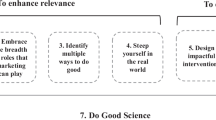Abstract
Since being recognized as a separate field of inquiry over 75 years ago, marketing has made enormous strides in terms of becoming a scholarly discipline. Marketing scholars have used scientific approaches to discover and document a number of regularities pertaining to consumer behavior and marketing exchages. Many regularities that have been empirically validated have achieved the status of “lawlike generalizations.” In this article, the authors first classify these generalizations into four categories: location centric, time centric, market centric, and competition centric. They then argue that each category is now being affected by at least one major contextual discontinuity that is likely to challenge the relevance, if not validity, of these well-accepted lawlike generalizations. The authors also identify important questions stemming from these discontinuities and issue a call for further research to discover new insights and paradigms.
Similar content being viewed by others
References
Aaker, David. 1991.Managing Brand Equity. New York: Free Press.
Alba, Joseph, John Lynch, Barton Weitz, Chris Janiszewski, Richard Lutz, Alan Sawyer, and Stacy Wood. 1997. “Interactive Home Shopping: Consumer, Retailer, and Manufacturer Incentives to Participate in Electronic Marketplaces.”Journal of Marketing 61 (Summer): 38–53.
Alderson, Wroe. 1945. “Factors Governing the Development of Marketing Channels.” InMarketing Channels. Ed. R. M. Clewett. Homewood, IL: Irwin.
Anderson, Eugene W., Claes Fornell, and Donald R. Lehmann. 1994. “Customer Satisfaction, Market Share, and Profitability: Findings From Sweden.”Journal of Marketing 58 (3):53–66.
Anterasian, Cathy, John L. Graham, and R. Bruce Money. 1996. “Are U.S. Managers Superstitious About Market Share?”Sloan Management Review 37(4):67–77.
Arthur, W. Brian. 1996. “Increasing Returns and the New World of Business.”Harvard Business Review 74 (4):100–109.
Assael, Henry and A. Marvin Roscoe, Jr. 1976. “Approaches to Market Segmentation Analysis.”Journal of Marketing 40(October):67–76.
Bass, Frank M. 1969. “A New Product Growth Model for Consumer Durables.”Management Science 15(January):215–227.
— 1995. “Empirical Generalizations and Marketing Science: A Personal View.”Marketing Science 14(3):G6-G19.
— 1995. “Introduction to the Special Issue: Empirical Generalizations in Marketing.”Marketing Science 14(3):G1-G5.
Bharadwaj, Sundar and Terry Clark. 1998. “Marketing, Market Growth and Endogenous Growth Theory: An Inquiry Into the Causes of Market Growth.” Paper presented at the Marketing Science Institute/Journal of Marketing Conference on Fundamental Issues and Directions for Marketing, June 5–6, Cambridge, MA.
Blattberg, Robert C., Richard Briesch, and Edward J. Fox. 1995. “How Promotions Work.”Marketing Science 14(3):G79-G85.
—, Thomas Buesing, and Subrata Sen. 1980. “Segmentation Strategies for New Brands.”Journal of Marketing 44(Fall):59–67.
Boulding, William and Richard Staelin. 1995. “Identifying Generalizable Effects of Strategic Actions on Firm Performance: The Case of Demand-Side Returns to R & D Spending.”Marketing Science 14(3): G222-G231.
Brandenburger, Adam M. and Barry J. Nalebuff. 1996.Coopetition. New York: Doubleday.
Breyer, Ralph F. 1934.The Marketing Institution. New York: McGraw-Hill.
Buzzell, Robert D. 1983. “Is Vertical Integration Profitable?”Harvard Business Review 61(January–February):92–102.
Buzzell, Robert D. 1998. “In Search of Marketing Principles.” Paper presented at the Academy of Marketing Science Annual Conference on Current Developments in Marketing, May 27–30, Norfolk, VA.
— and Bradley T. Gale. 1987.The PIMS Principles: Linking Strategy to Performance. New York: Free Press.
— and Gwen Ortmeyer. 1995. “Channel Partnerships Streamline Distribution.”Sloan Management Review 36 (3): 85–96.
Carmody, Deirdre. 1991. “Threats to Mass Circulation on Demographic Landscape.”The New York Times, January 7.
Carpenter, Gregory S., Rashi Glazer, and Kent Nakamoto. 1998. “Market-Driving Strategy: Toward a New Concept of Competitive Advantage.” Paper presented at the Marketing Science Institute/Journal of Marketing Conference on Fundamental Issues and Directions for Marketing, June 5–6, Cambridge, MA.
Contractor, Farok J. and Peter Lorange. 1988. “Why Should Firms Cooperate? The Strategy and Economic Basis for Cooperative Ventures.” InCooperative Strategies in International Business Eds. Farok J. Contractor and Peter Lorange. Lexington, MA: Lexington Books.
Converse, Paul D.. 1949. “New Laws of Retail Gravitation.”Journal of Marketing 14 (October): 379–384.
Davis, Stan. 1987.Future Perfect. Reading, MA:Addison-Wesley.
Day, George S., 1981. “The Product Life Cycle: Analysis and Application Issues.”Journal of Marketing 45 (Fall): 60–67.
— 1998. “What Does It mean to be Market-Driven?”Business Strategy Review 9 (1): 1–14.
Dekimpe, Mamik G. and Dominique M. Hanssens. 1995. “Empirical Generalizations About Market Evolution and Stationarity.”Marketing Science 14 (3): G122-G131.
Dhalla, N. K. and S. Yuspeh. 1976. “Forget the Product Life Cycle Concept!”Harvard Business Review 54 (January–February): 102–110.
Doyle, Peter and John Saunders. 1985. “Market Segmentation and Positioning in Specialized Markets.”Journal of Marketing 49 (Spring): 24–32.
Gardner, David 1987. “The Product Life Cycle: A Critical Look at the Literature.” InReview of Marketing. Ed. Michael J. Houston. Chicago: American Marketing Association.
Ghemawat, Pankaj. 1986. “Sustainable Advantage.”Harvard Business Review 64 (September–October): 53–58.
Ghosh, Avijit and Samuel Craig. 1983. “Formulating Retail Location Strategy in a Changing Environment.”Journal of Marketing 47 (Summer): 56–68.
Haley, Russell I.. 1968. “Benefit Segmentation: A Decision-Oriented Research Tool.”Journal of Marketing 32 (July): 30–35.
Hamel, Gary. 1996. “Strategy as Revolution.”Harvard Business Review 74 (July/August): 69–82.
— and C. K. Prahalad. 1991. “Corporate Imagination and Expeditionary Marketing.”Harvard Business Review 69 (July–August): 81–92.
Huff David L. 1964. “Defining and Estimating a TradingArea.”Journal of Marketing 28 (July): 34–38.
Hunt, Shelby D. 1976. “The Nature and Scope of Marketing.”Journal of Marketing 40 (July): 17–28.
Hurley, Robert F. and Tomas M. Hult. 1998. “Innovation, Market Orientation, and Organizational Learning: An Integration and Empirical Examination.”Journal of Marketing 62 (Summer): 42.
Jacoby, Jacob and Robert W. Chestnut. 1978.Brand Loyalty: Measurement and Management. New York: John Wiley.
Jaworski, Bernard J. and Ajay K. Kohli. 1993. “Market Orientation: An tecedents and Consequences.”Journal of Marketing 57 (Summer): 53–70.
Kalyanraman, Gurumurthy, William T. Robinson, and Glen L. Urban. 1995. “Order of Market Entry: Established Empirical Generalizations, Emerging Empirical Generalizations and Future Research.”Marketing Science 14 (3): G212-G226.
Kapferer, Jean-Noel. 1994.Strategic Brand Management: New Approaches to Creating and Evaluating Brand Equity. New York: Free Press.
Keith, Robert I., 1960. “The Marketing Revolution.”Journal of Marketing 24 (January): 35–38.
Keller, Kevin Lane. 1993. “Conceptualizing, Measuring and Managing Customer-Based Brand Equity.”Journal of Marketing 57 (January): 1–22.
Kerin, Roger A., 1996. “In Pursuit of an Ideal: The Editorial and Literary History of the Journal of Marketing.”Journal of Marketing 60 (Winter): 1.
Kodama, Fumio. 1992. “Technology Fusion and the New R&D.”Harvard Business Review 70 (July–August): 70–78.
Kohli, Ajay K. and Bernard J. Jaworski. 1990. “Market Orientation: The Contruct, Research Propositions, and Managerial Implications.”Journal of Marketing 54 (April): 1–18.
Kotler, Philip and Ravi Singh. 1981. “Marketing Warfare in the 1980s.”Journal of Business Strategy 2 (Winter): 30–41.
Kumar, Nirmalya and Lisa Scheer. 1998. “radical and Incremental Product Innovation Among Market Driven and Market Driving Firms.” Paper presented at the Marketing Science Institute;Journal of Marketing Conference on Fundamental Issues and Directions for Marketing, June 5–6, Cambridge, MA.
Levitt, Theodore. 1965. “Exploit the Product Life Cycle.”Harvard Business Review 43 (November–December): 81–94.
Lewis, Peter H. 1998. “Web Concern Gets Patent for Electronic Business Model.”The New York Times, August 10.
Mahajan, Vijay, Eitan Mueller, and Frank M. Bass. 1995. “Diffusion of New Products: Empirical Generalizations and Managerial Uses.”Marketing Science 14 (3): G79-G85.
Miller, Greg. 1998. “ ‘Coopetition’ Among Internet Rivals.”Los Angeles Times, May 11.
Narver, John C. and Stanley E Slater. 1990. “The Effect of a Market Orientation on Business Profitability.”Journal of Marketing 54 (October): 20–35.
Negroponte, Nicolas. 1995.Being Digital. New York: Knopf.
Norton, John A. and Frank M. Bass. 1987. “A Diffusion Theory Model of Adoption and Substitution for Successive Generations of High Technology Products.”Management Science 33 (September): 1069–1086.
— and —. 1992., “Evalution of Technological Generations: The Law of Capture.”Sloan Management Review 33 (2): 66–77.
Nua Internet Surveys. 1998. http://www.nua.ie/surveys/
Nyquist, Jody D., Mary Jo Bitner, and Bernard H. Booms. 1985. “Identifying Communication Difficulties in the Service Encounter.” InThe Service Encounter. Eds. John Czepiel, Michael Solomon, and Carol Suprenant. Lexington, MA: Lexington Books.
Plummer, Joseph T. 1974. “The Concept and Application of Life Style Segmentation.”Journal of Marketing 38 (January): 33–37.
Porter Michael. 1980.Competitive Strategy: Techniques for Analyzing Industries and Competitors. New York: Free Press.
Prahalad, C. K. 1995. “Weak Signals Versus Strong Paradigms.”Journal of Marketing Research 32 (Summer): iii.
— and Gary Hamel. 1990. “The Core Competence of the Corporation.”Harvard Business Review 68 (May–June): 79–91.
Reibstein, David J. and Paul W. Farris. 1995. “Market Share and Distribution: A Generalization, a Speculation and Some Implications.”Marketing Science 14 (3): G190-G205.
Reilly, William J. 1931.The Law of Retail Gravitation. Austin: University of Texas Press.
Reynolds, Robert B. 1953. “A Test of the Law of Retail Gravitaiton.”Journal of Marketing 17 (January): 273–277.
Rogers Everett. 1962.Diffusion of Innovations. New York: Free Press
Sarkar, Mitrabarun, Brian Butler, and Charles Steinfeld. 1998. “Cybermediaries in electronic Marketspace: twoard Theory Building.”Journal of Business Research. 41: 215–221.
Sheth, Jagdish N. 1981. “Psychology of Innovation Resistance: The Less Developed Concept (LDC) in Diffusion Research.” InResearch in Marketing, Vol. 4. Ed. Jagdish N. Sheth. Greenwich, CT: JAI.
— 1992. “Emerging Marketing Strategies in a Changing Macroeconomic Environment: A Commentary.”International Marketing Review 9 (1): 57–63.
— and Banwari Mittal. 1996. “A Framework for Managing Customer Expectations.”Journal of Market Focused Management 1: 137–158.
—,—, and Bruce Newman. 1999.Customer Behavior: Consumer Behavior and Beyond. New York: Dryden.
—, and Atul Parvatiyar. 1992. “Towards a Theory of Business Alliance Formation.”Scandinavian International Business Review 1 (3): 71–87.
— and S. Ram. 1987.Bringing Innovation to Market. New York: John Wiley.
— and Rajendra S. Sisodia. 1995. “Feeling the Heat.”Marketing Management 4 (Fall): 8–23.
—, David M. Gardner, and Dennis E. Garrett. 1988.Marketing Theory: Evolution and Evaluation New York: John Wiley.
Simon, Hermann. 1994. “Marketing Science's Pilgrimage to the Ivory Tower.” InResearch Traditions in Marketing. Eds. Gilles Laurent, Gary L. Lilien, and Bernard Pras. Boston: Kluwer.
Slater, Stanley F. and John C. Narver. 1995. “Market Orientation and the Learning Organization.”Journal of Marketing 59 (July): 63–74.
Szymanski, David M., Sundar G. Bharadwaj, and P. Rajan Varadarajan. 1993. “An Analysis of the Market Share-Profitability Relationship.”Journal of Marketing 57 (Summer): 1.
Treacy, Michael and Fred Wiersema. 1995.The Discipline of Market Leaders. Reading, MA: Addison-Wesley.
Tushman, Michael L. and Charles A. O'Reilly III. 1996. “Ambidextrous Organizations: Managing Evolutionary and Revolutionary Change.”California Management Review 38 (Summer): 8–30.
— and —. 1997.Winning Through Innovation: A Practical Guide to Leading Organizational Change and Renewal. Boston: Harvard Business School Press.
Vaile, Roland S., E. T. Grether, and Reavis Cox 1952.Marketing in the American Economy. New York: Ronald Press.
Williamson, Oliver E. 1975.Markets and Hierarchies: Analysis and Antitrust Implications. New York: Free Press.
Winter, Frederick W. 1979. “A Cost-Benefit Approach to Market Segmentation.”Journal of Marketing 43 (Fall): 103–111.
Wysocki, Bernard, Jr. 1997. “Wealth of Notions.”Wall Street Journal, January 26.
Zinkham, George M. and Ruby Hirschheim. 1992. “Truth in Marketing Theory and Research: An Alternative Perspective.”Journal of Marketing 56 (April): 80–88.
Author information
Authors and Affiliations
Additional information
Jagdish N. Sheth is the Charles Kellstadt Professor of Marketing at the Gouizeta Business School, Emory University. He has published 26 books and more than 200 articles in marketing and other business disciplines. His book,The Theory of Buyer Behavior (with John A. Howard), is a classic in the field of consumer behavior and is one of the most cited works in marketing. his other books includeMarketing Theory: Evolution and Evaluation (with David Gardner and Dennis Garrett) andConsumption Values and Market Choices: Theory and Applications (with Bruce Newman and Barbara Gross).
Rajendra S. Sisodia is Trustee Professor of Marketing at Bentley College. Previously, he was an associate professor of marketing and director of executive programs at George Mason University and assistant professor of marketing at Boston University. He has a Ph.D. in marketing from Columbia University. He has published more than 40 articles in journals such asHarvard Business Review, Journal of Business Strategy, Marketing Letters, andMarketing Management. He has also authored about two dozen cases, primarily on strategic and marketing issues in the telecommunications industry, as well as a number of telecommunications industry and company analyses.
Rights and permissions
About this article
Cite this article
Sheth, J.N., Sisodia, R.S. Revisiting marketing's lawlike generalizations. J. of the Acad. Mark. Sci. 27, 71–87 (1999). https://doi.org/10.1177/0092070399271006
Issue Date:
DOI: https://doi.org/10.1177/0092070399271006




